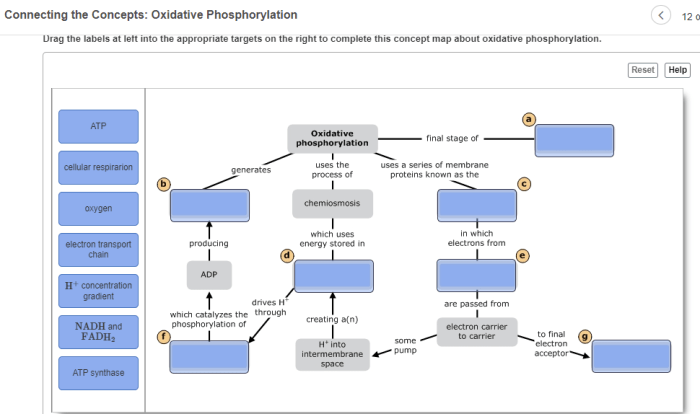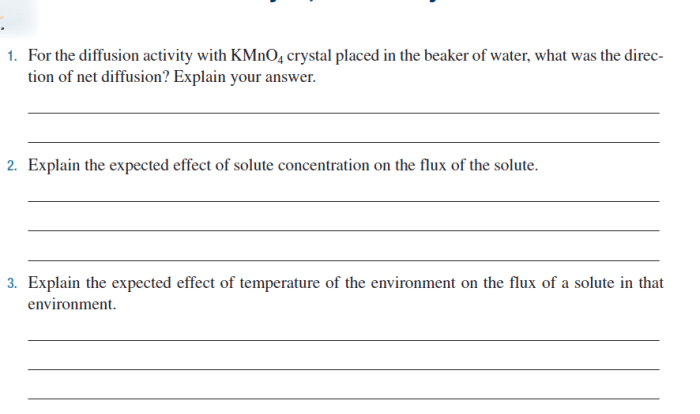Concept map about oxidative phosphorylation – Oxidative phosphorylation, a fundamental concept in cellular biology, stands as a cornerstone of cellular respiration and energy production. This concept map delves into the intricate workings of this complex process, exploring its mechanisms, components, and regulation, providing a comprehensive understanding of how cells harness energy to fuel their vital functions.
Within this map, we will traverse the electron transport chain, unraveling the structure and function of each complex. We will elucidate the mechanism of chemiosmosis, examining how the proton gradient drives ATP synthesis. Moreover, we will delve into the structure and function of ATP synthase, dissecting the roles of F0 and F1 subunits in ATP synthesis.
Oxidative Phosphorylation Overview: Concept Map About Oxidative Phosphorylation

Oxidative phosphorylation is a crucial metabolic pathway in cellular respiration that generates most of the cell’s ATP, the primary energy currency. It involves the transfer of electrons through a series of protein complexes in the inner mitochondrial membrane, coupled to the pumping of protons across the membrane, creating a proton gradient.
This gradient drives the synthesis of ATP by ATP synthase.
Electron Transport Chain (ETC), Concept map about oxidative phosphorylation
The ETC is a series of four protein complexes (I-IV) located in the inner mitochondrial membrane. Each complex contains multiple subunits, including flavoproteins, cytochromes, and iron-sulfur proteins. Electrons are passed along the ETC, from NADH or FADH2 to oxygen, with each complex pumping protons across the membrane.
Chemiosmosis
Chemiosmosis is the mechanism by which the proton gradient across the inner mitochondrial membrane drives ATP synthesis. The proton gradient creates an electrochemical potential that causes protons to flow back across the membrane through ATP synthase, a protein complex that couples proton flow to the synthesis of ATP.
ATP Synthase
ATP synthase is a multi-subunit enzyme that consists of a membrane-embedded F0 complex and a peripheral F1 complex. The F0 complex forms a proton channel, while the F1 complex contains the catalytic site for ATP synthesis. Proton flow through the F0 complex drives the rotation of the F1 complex, which in turn synthesizes ATP.
Regulation of Oxidative Phosphorylation
Oxidative phosphorylation is regulated by various factors, including the availability of substrates (NADH and FADH2), the proton gradient across the membrane, and the activity of regulatory proteins. Inhibitors, such as rotenone and cyanide, can block specific complexes of the ETC, while uncouplers, such as 2,4-dinitrophenol, can disrupt the proton gradient, preventing ATP synthesis.
Disorders of Oxidative Phosphorylation
Defects in oxidative phosphorylation can lead to various disorders, including mitochondrial encephalopathy, lactic acidosis, and stroke-like episodes (MELAS), Leigh syndrome, and Kearns-Sayre syndrome. These disorders are characterized by impaired energy production, leading to neurological, muscular, and cardiac symptoms.
FAQ Overview
What is the significance of oxidative phosphorylation in cellular respiration?
Oxidative phosphorylation is the primary mechanism by which cells generate ATP, the universal energy currency, during cellular respiration.
How does the electron transport chain contribute to oxidative phosphorylation?
The electron transport chain is a series of protein complexes that transfer electrons, creating a proton gradient across the inner mitochondrial membrane, which drives ATP synthesis.
What is the role of chemiosmosis in oxidative phosphorylation?
Chemiosmosis is the process by which the proton gradient generated by the electron transport chain drives the synthesis of ATP through ATP synthase.
How is ATP synthase involved in oxidative phosphorylation?
ATP synthase is an enzyme that utilizes the proton gradient to drive the synthesis of ATP from ADP and inorganic phosphate.
What factors regulate oxidative phosphorylation?
Oxidative phosphorylation is regulated by a variety of factors, including substrate availability, oxygen concentration, and the activity of inhibitors and uncouplers.


